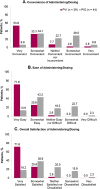Patients' administration preferences: progesterone vaginal insert (Endometrin®) compared to intramuscular progesterone for Luteal phase support
- PMID: 25385669
- PMCID: PMC4414383
- DOI: 10.1186/1742-4755-11-78
Patients' administration preferences: progesterone vaginal insert (Endometrin®) compared to intramuscular progesterone for Luteal phase support
Abstract
Background: Administration of exogenous progesterone for luteal phase support has become a standard of practice. Intramuscular (IM) injections of progesterone in oil (PIO) and vaginal administration of progesterone are the primary routes of administration. This report describes the administration preferences expressed by women with infertility that were given progesterone vaginal insert (PVI) or progesterone in oil injections (PIO) for luteal phase support during fresh IVF cycles.
Methods: A questionnaire to assess the tolerability, convenience, and ease of administration of PVI and PIO given for luteal phase support was completed by infertile women diagnosed with PCOS and planning to undergo IVF. The women participated in an open-label study of highly purified human menopausal gonadotropins (HP-hMG) compared with recombinant FSH (rFSH) given for stimulation of ovulation.
Results: Most women commented on the convenience and ease of administration of PVI, while a majority of women who administered IM PIO described experiencing pain. In addition, their partners often indicated that they had experienced at least some anxiety regarding the administration of PIO. The most distinguishing difference between PVI and PIO in this study was the overall patient preference for PVI. Despite the need to administer PVI either twice a day or three times a day, 82.6% of the patients in the PVI group found it "very" or "somewhat convenient" compared with 44.9% of women in the PIO group.
Conclusions: The results of this comprehensive, prospective patient survey, along with findings from other similar reports, suggest that PVI provides an easy-to-use and convenient method for providing the necessary luteal phase support for IVF cycles without the pain and inconvenience of daily IM PIO. Moreover, ongoing pregnancy rates with the well-tolerated PVI were as good as the pregnancy rates with PIO.
Trial registration: ClinicalTrial.gov, NCT00805935.
Figures
References
Publication types
MeSH terms
Substances
Associated data
LinkOut - more resources
Full Text Sources
Other Literature Sources
Medical
Research Materials
Miscellaneous


